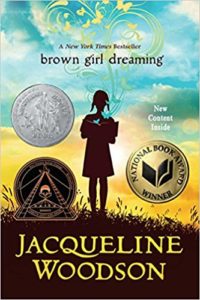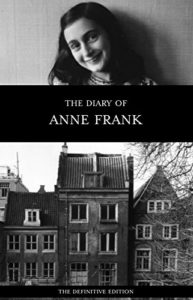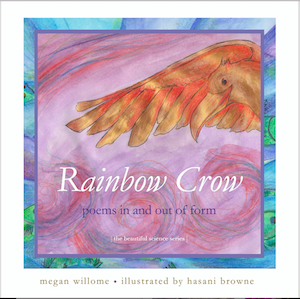How many of you wrote a book and “published” it when you were a child? I did — and illustrated it too. “Sammy and Mary” was a love story between two squirrels. I wrote and drew the book on a yellow legal pad and bound it using a department store shirt box.
As a child, author and poet Jacqueline Woodson wrote a book too, “Butterflies,” described in the poem “first book” in her poetry memoir titled Brown Girl Dreaming.
There are seven of them,
Not enough for a real book until
I cut each page into small squares
staple the squares together, write
one poem
on each page.
And just like that, she’s a writer.
Of course, this poem is on page 252 of a 320-page book, so she’s already been a writer. “Words are my brilliance,” she writes in “the selfish giant.”
Brown Girl Dreaming is about a brown girl with big dreams, growing up in the ‘60s and ‘70s in Columbus, Ohio; Greenville, South Carolina; and Brooklyn, New York. It is about race, but it’s also about cricket lullabies, funk music, Jehovah’s Witnesses, lead poisoning, learning difficulties, butterflies, and family. In other words, it’s about life.
But mostly, it’s about becoming a writer, which is why I bought it even before it won the National Book Award, the Coretta Scott King Award, and received the Newbery Honor. Because it’s a memoir told through poems, all at a middle-grade reading level, it’s for anyone who loves to read and write.
The Jackie behind and inside the poems is a girl who makes up stories, sometimes stories she’s told are “too good.” She’s inspired by Robert Frost, Langton Hughes, Oscar Wilde, and Soul Train. The question for the reader is how is this girl going to reach her goal? She describes one of her challenges in “writing #1.”
… The story
wakes up and walks all over the room. Sits in a chair,
crosses one leg over the other, says,
Let me introduce myself. Then just starts going on and on.
But as I bend over my composition notebook,
only my name
comes quickly. Each letter, neatly printed
between the pale blue lines. Then white
space and air and me wondering, How do I
spell introduce? Trying again and again
until there is nothing but pink
bits of eraser and a hole now
where a story should be.
Like all good heroes, Jackie has limitations, as described in Sanderson’s Second Law. She doesn’t read well. She’s not good at actual writing either, shortening her name in the poem “late autumn” to Jackie so she doesn’t have to complete the impossible task of linking the cursive c to q to u to spell Jacqueline. After her parents divorce, she’s raised sometimes by a single mother and sometimes by grandparents. She’s also a girl, and the writers she admires are men, even the author of the picture book about Stevie, the first one she’s ever seen with brown people like her.
Even though the poems are written from child-Jackie’s perspective, she is observant. That means we readers get insight into characters that she doesn’t have. For example, we know Uncle Robert is up to no good long before Jackie does because of stanzas like this in “far rockaway”:
He says he won’t forget,
asks us if he’s a man of his word and
everyone except my mother
nods.
We also feel empathy for Jackie’s mother, even as she leaves her kids with her parents and goes to New York to have another baby. We get a child’s view into what it is like to be raised Jehovah’s Witness, what it feels like when Coraandhersisters use the swing set in Daddy Gunnar’s yard on Sunday afternoons, when Jackie and her siblings are made to rest from playing outside. We learn the importance of a name — a word associated with what it means to be you — and what it means for a boy to inherit his grandfather’s name, Hope.
In the Author’s Note, Woodson writes, of the process of putting together this memoir, “I think my life was at once ordinary and amazing.” Most lives are a mix of both, and sometimes we don’t know which parts are amazing and which are ordinary until we write them down. I think Woodson discovered which was which in writing this memoir.
In one of the last poems, “the earth from far away,” Jackie remembers this first moment of writing:
… Once
there was only the letter J and my sister’s hand
wrapped around mine, guiding me, promising me
infinity.
This book is a piece of infinity, teaching us how to listen (there are ten haiku with that title), how to dream, how to wait for the day like the one in “a writer” when Jackie finally becomes the thing she longs to be, despite her limitations:
You’re a writer, Ms. Vivo says, holding my poem out to me
_______________
The next Children’s Book Club will meet Friday, October 14. We’ll read The Diary of a Young Girl, by Anne Frank. Please make sure you check out the copy with the subtitle “The Definitive Edition.” If you, like me, read the book before 1998, you haven’t read the most complete version.
Photo by Bong Grit 20121227 Kyoto Umekouji 2, Creative Commons, via Flickr. Post by Megan Willome, author of The Joy of Poetry.
Browse more Children’s Book Club
“Megan Willome has captured the essence of crow in this delightful children’s collection. Not only do the poems introduce the reader to the unusual habits and nature of this bird, but also different forms of poetry as well.”
—Michelle Ortega, poet and children’s speech pathologist
- Perspective: The Two, The Only: Calvin and Hobbes - December 16, 2022
- Children’s Book Club: A Very Haunted Christmas - December 9, 2022
- By Heart: ‘The night is darkening round me’ by Emily Brontë - December 2, 2022




Marilyn says
I so enjoyed this book, Megan! I was initially interested in the form, that it was a memoir in verse, but was quickly caught up in the story. I enjoy reading about people whose experiences are different from mine, then pondering the commonalities. Her journey of self-discovery – that she is a writer – is a rich thread in this tapestry.
I made a lot of margin notes in this book!
Megan Willome says
Me too, Marilyn!
I’m so glad you read it, and I think one of the best reasons to do so is for, as you say, the differences and commonalities in experience.
Callie Feyen says
I read Jaqueline Woodson to Kindergarteners and first graders each year. We read The Other Side, which is one of her picture books. It’s about a two girls of different races trying to figure out why it is they’ve been told they can’t go on the other side of their fence. Eventually they sit on the fence together.
I tell the kids that Woodson is an author to grow up with, and then I go on to show them her other books – chapter books, Brown Girl Dreaming, other picture books. She is one of my favorites. I think my favorite of hers is After Tupac and D Foster. I love how she captures the dialogue of the kids in the story, and also, I love Tupac. 🙂
Megan Willome says
Callie, thanks so much for these recommendations of other titles by Woodson. I haven’t read any of them.
I’m also glad to know her work has been useful in the classroom. It makes me happy when a critically acclaimed book also gets praise from real kids.
Marilyn says
Callie, I echo Megan’s appreciation for the other titles! Thank you.
Sharon A Gibbs says
Callie, how wonderful it must be to be a student of yours!
L.L. Barkat says
Really hard to put this book into a handful of words that capture it, but you’ve done that so beautifully, Megan.
Also, it makes me, yet again, want kids to be able to tell their stories without being blocked by technicalities. Storytelling can be done as one activity (more quickly and richly via role plays with certain kinds of toys and found materials), while handwriting can be done as another. I wish, I wish, I wish.
Megan Willome says
Yes, I wish too, L.L. And yet it’s so rare in classrooms.
I think Woodson has written poignantly about what it feels like to have trouble reading and writing. She shows us in poem after poem.
I know someone who was not diagnosed with dyslexia until she was out of high school. She’s Latina, and the assumption was that she was stupid and would just drop out of school anyway, so no teachers pushed to learn why she was having trouble learning. Now she has a daughter who is having trouble reading, and she pushed for her child to get tested. The daughter is also dyslexic. This woman is also looking at the generation above her, at loved ones who never finished high school, and suspects that this may have been an unseen factor.
Sharon Gibbs says
There is so much to love about this book. First, I borrowed the audiobook from my library’s cloud Library. Then I borrowed the eBook version but before I finished it, I knew I needed my own copy and clicked my way to Amazon. My copy, full of highlights and notes, is one I know I will return to again.
As L.L. says, it is hard to put this book into a handful of words. We could spend days discussing (over tea, of course ☺) the many other themes (home, race, social injustice, memory, family, faith, finding oneself, and keeping one’s dreams alive).
Her free verse format and limited-omniscient child’s perspective perfectly chronicles the life of a girl who could see what was happening but wasn’t told why. She discovered meaning through her writing and found her own answers, abilities, and expression.
Another interesting observation: the titles of the parts of the book are all in small casing—perhaps how a child would write. And notice how Part I and V tell the bigger picture: “i am born” and “ready to change the world.”
Change the world, she did.
Megan Willome says
Sharon, as always, your insights are spot on!
I had not paid attention to the progression from parts 1 to 4, so I’m glad you brought that out. I do think the lowercase titles emphasize her view as a child, almost like Alison Bechdel does with alternating Small Alison (child) Medium Alison (teenager, young adult). We’re getting the story through the poems of Small Jackie, later to become Jacqueline.